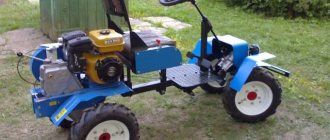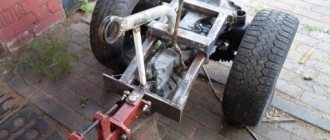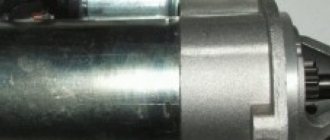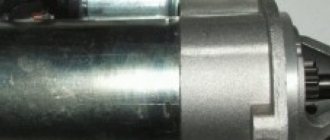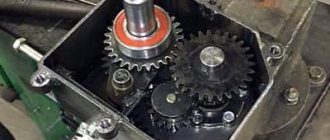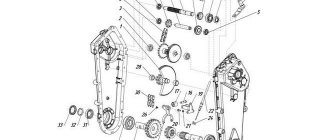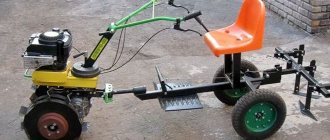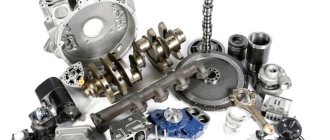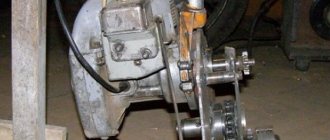General excursion into technology
Over the many decades of its existence, a wide range of walk-behind tractors has rolled off the assembly line of the Minsk Tractor Plant.
For those whose activities are closely related to plowing the land, the classic model MTZ 05 is well known. This walk-behind tractor, produced back in the Soviet years, is still in demand today, and it can be successfully converted into a mini tractor. However, the most suitable models for the production of prefracture are MTZ-12 and MTZ-09N. Firstly, these are the most powerful walk-behind tractors, which increases productivity. Secondly, the very design of the units allows them to be easily and quickly converted into a mini tractor. This saves your personal effort, time and money. A special feature of MTZ walk-behind tractors is that they are equipped with 2-cylinder diesel engines, and homemade mini tractors based on them are not three-wheeled, but four-wheeled.
Materials and tools
To assemble a mini tractor based on a walk-behind tractor, you will need, in addition to the Neva itself:
- electric welding machine;
- grinding machine (for rolling and fitting);
- drill;
- a set of necessary simple tools;
- winch, jack system;
From the materials required for construction:
- Dashboard;
- A pair of wheels suitable in size and strength;
- Hub brake system;
- Steering rod;
- Steering rods;
- Transmission;
- Angles, pipes or profiles;
- Canopy system;
Alternative options
For conversion into a mini tractor, not only walk-behind tractors produced by MTZ are used, but also products from other brands. Each model has its own characteristics, but in general the assembly algorithm differs little.
“Neva”, “Centaur”, “Bison”, “Agro”
Motoblocks "Neva" are equipped with Subaru engines. The machines have a lot of power and are quite heavy, so converting them into a mini tractor simplifies control. A coupling mechanism is supplied with the design of this brand. It is intended for various attachments, thus solving the problem of connecting it to the machine. Motoblocks "Centaur" are equipped with a diesel engine. It is mounted in the front of the frame, which is traditional for such equipment. Meanwhile, torque is transmitted to the rear pair of wheels through the use of a belt or gear drive.
Motoblocks of various capacities are produced under the Zubr brand. To reconstruct them into a mini tractor, it is recommended to use heavy models. They are equipped with a liquid cooling system, which makes it possible to work in adverse weather. To build a control system, you can use a VAZ gearbox, and for the stopping system, mechanical belt-type brakes are used.
When producing a mini tractor from Agro walk-behind tractors, remember one important feature. Their standard axle is characterized by low fracture strength, thereby increasing the risk of destruction during operation
To avoid this, you need to strengthen it. For this purpose, modernized wheel gearboxes designed for VAZ or LuAZ SUVs are used.
"Oka", "Salyut", "Cascade"
Mini tractors made from the Oka walk-behind tractor are equipped with a reversible gearbox, including two speeds. When converted, they are equipped with a frame and all-wheel drive, making all wheels driving. The engine is mounted at the front and has a factory hood to protect it. The transfer case is located in the rear. The drive of both axles with chain gearboxes is also located there.
Engines from leading brands are installed in Salyut walk-behind tractors. Their power usually varies between 6–7.5 l/s. The gearbox is equipped with two main gears and an additional reduction gear. The kinematic scheme involves the use of two V-belts, due to which:
- the quality of torque transmission improves;
- the risk of dangerous slippage that can occur under active loads is reduced;
- the useful life of the machine increases.
If you make a mini tractor from a Salyut walk-behind tractor, it is advisable to increase the wheel track of the rear and front axles to 1200 mm. This manipulation will increase the stability of the vehicle. For the drive wheels, and there can be either two or all 4 of them, only standard tires are used.
When making a mini tractor yourself from “Cascade” walk-behind tractors, you can use “stockings” from old rear-wheel drive “Muscovites” or “Zhiguli” in the design of its rear axle. During operation, the “stockings” are shortened, which optimizes the wheel track parameters. To build a control system, it is convenient to use a rotating beam from PAZ buses, while the hubs and gearboxes are taken from Zhiguli cars.
Requirements for a homemade walk-behind tractor
- Power, taking into account the possible processing area
- What type of fuel will you use, and, accordingly, your priorities in speed or economy.
- It is worth considering the cost of the walk-behind tractor, since world-famous and well-known brands will cost an order of magnitude more. And therefore it is better to give preference to a domestic manufacturer.
Among the affordable and optimal quality walk-behind tractors, we can mention the following walk-behind tractors: AGRO, Neva, MTZ, Centaur, Zubr.
The listed models have a number of advantages and they should be chosen based on subjective needs and tasks.
Preparing to create a homemade mini-tractor
To create a mini-tractor based on a walk-behind tractor, you need to draw up a drawing, its kinematic diagram, and also prepare materials, tools and equipment in advance. If you have the required knowledge and skills, then you can figure out how to develop a mechanism demonstration scheme yourself. But if you don’t have such skills, then you can find a more suitable option online.
For a homemade mini tractor, you can use a purchased factory kit for parts and components. But such a decision cannot be called correct for those who intend to break a 4x4 and save on this procedure.
For the technique you need:
- set of tools;
- equipment for welding work;
- drill with various drill bits;
- pipes, channels made of metal;
- nuts, bolts;
- grinder and discs for working with metal.
Attention!
Purchasing a ready-made set of spare parts for conversion is the main expense item on which you should not save. Otherwise, the quality of the finished structure will leave much to be desired.
In addition, for a homemade tractor you need to select two wheels, a hitch, a driver’s seat, a steering mechanism, pedals and a walk-behind tractor with the required weight and power. Ideally, it would be a heavy-duty vehicle with a diesel engine. Thanks to this, you will have a home-made, yet powerful mini-tractor at your disposal that will effectively cope with agricultural tasks.
When choosing the weight of a new mini tractor, you must take into account the condition of the land on which it will be used. If it is compacted and dry, then the unit may not cope with the task assigned to it. Therefore, the harder the soil, the harder it is to choose a walk-behind tractor. And the power of the motor must be correlated with the area of the area that will be processed by such a tractor. Therefore, the larger it is, the more productive the engine should be.
Gearbox of the Neva MB-2 walk-behind tractor: diagram and design, purpose and operating rules
The gearbox is an indispensable component of any equipment that uses an engine, since without it it is impossible to transmit rotational motion. Structurally, this element in the Neva-MB-2 walk-behind tractors is similar to parts used in other equipment, but to learn more about it, it is necessary to study the issue in more detail.
Peculiarities
The design of the walk-behind tractor is equipped with a gear-chain unit, the main task of which is to transmit rotational motion, and therefore to change the rotation speed of the cutters. It is thanks to the gearbox that the driven pulley transmits the mechanical action to the wheels of the equipment, thereby changing the speed and direction.
Inside the housing there is oil, which is necessary to ensure the operation of the gearbox. The element is enclosed in a durable sealed housing. Its kinematic scheme consists of a chain and two stars located in opposite directions. The lower one is called the driven one, because it stands on the shaft and drives the entire walk-behind tractor system.
Compound
The walk-behind tractor gearbox includes the following important parts:
- screws;
- bearings;
- axles;
- stars;
- frame;
- bushings;
- shift levers;
- gears;
- shaft;
- coupling;
- axle shafts;
- pay;
- spring.
These are not all the elements that are involved in the design of the gearbox, but they are the main ones. Failure of one of them leads to loss of performance and subsequent repairs.
Compared to a worm gearbox, a gear-chain gearbox is more reliable. It is convenient and easy to operate, and can support reverse function. As a rule, this is a collapsible structure, where all elements are connected to each other with bolts, thanks to which you can inspect the condition of chains and gears if necessary. Such gearboxes are installed on large walk-behind tractors, which require a durable and reliable unit to transfer force to the wheels and cutters.
Application nuances
In order for the user to have to deal with walk-behind tractor breakdowns as little as possible, it is necessary to monitor the operation of not only the engine, but also the gearbox. Experts give their advice on what basic requirements must be observed during operation.
It is important to use only high-quality oil, and at the same time regularly check its presence inside the element. According to GOST, TAD-17I or an analogue, which can also be easily found in stores - TAP-15V, is ideal for this gearbox. A complete oil change should be carried out according to the engine hours specified by the manufacturer.
The instructions for users indicate that replacement should be made 30 hours after the first start of the walk-behind tractor, and subsequently after 150 hours. If the walk-behind tractor is put into storage, then all working fluids are removed from it, and the necessary moving elements are lubricated. Periodically, the user is required to check the tension level of the gearbox chain. If it sags, it is replaced with a new one, since this element cannot be repaired. The oil seal can be replaced independently, thanks to the completely dismountable design of the described unit.
Possible breakdowns
It is worth saying that the gearbox from the Neva-MB-2 walk-behind tractor can be repaired quickly and easily. This is possible due to the fact that you can always find spare parts for it on the market. This need arises when the following signs appear:
- oil begins to appear on the output shaft;
- the chain jams;
- no kinematic connection;
- Gears don't change.
In all of these cases, it is necessary to disassemble and inspect the gearbox. If oil leaks, the problem can be eliminated by simply replacing the cuff, which over time may lose its original qualities. Jamming is always associated with a broken chain, so this problem can only be eliminated by complete replacement.
If this element is intact, but there is no kinematic connection, you should pay attention to the sprockets present in the design. One of them could have broken off
If there is no gear shift, the crack is inspected, which may be destroyed. Sometimes the threaded part of the handle is cut off. If the user begins to notice that oil leakage is observed on the shift shaft, this is not always an indication of a breakdown. Sometimes the permissible oil level in the gearbox is simply exceeded. The excess just needs to be drained.
Specifications
| Walk-behind tractor type (GOST 28523-90): | Average |
| Dimensions: | Length: 135 or 151 cm Width: 60 or 62 cm Height: 110 or 133.5 cm |
| Dry weight: | average 72 kg (from 62 to 81 kg) |
| Power: | 3.5-6.5 hp (2.6-4.5 kW) |
| Traction force: | 60-70 kgf (up to 100 kgf on lugs) |
| Fuel consumption: | 290-435 g/kWh |
| Number of gears: | 2 (4) forward gears, 1 (2) reverse gear |
| Maximum speed on pneumatic wheels (second value when working on a large pulley diameter): | First gear – 2.8 (3.5) km/h Second gear – 6.3 (7.8) km/h Reverse – 2.0 (2.5) km/h |
| Gearbox: | Mechanical, gear |
| Gearbox oil: | TM-5-18 (TAD-17I), MS-20 |
| BOM shaft: | Power take-off pulley (PTO) for V-belt drive |
| Cutting width: | 35, 60, 80 cm |
| Diameter of cutter cultivators: | 310 mm |
| Plowing depth: | 10-25 cm |
| Wheel diameter: | 39-41 cm |
| Ground clearance: | 11-12 cm |
| Steering gear: | Rod |
| Limit angle of inclination during operation: | 15° |
Engines
One of the main decisions of Salyut engineers is to use not only domestic, but also imported engines from foreign manufacturers (Briggs & Stratton, Honda, Subaru, Lifan, etc.) on a domestically produced frame. Thanks to the use of imported motors, the durability and reliability of the Salyut-5 walk-behind tractor significantly increases, and comfort during operation also improves.
According to reviews from walk-behind tractor owners, the most reliable engines are the American Briggs Stratton and the Japanese Robin Subaru and Honda engines.
The first Salyut 5 models were equipped with Russian-made engines (KaDvi) of the DM series. They were significantly inferior to foreign engines in technical and operational parameters, so in the first half of the 2000s they were completely abandoned.
Gearbox
The pride of the Salyut-5 walk-behind tractor is its gearbox, which has become legendary, the mechanism of which is made entirely of gears. This is the plant’s own development, which was initially manufactured at the main enterprise in Moscow, and then at the facilities of the Omsk Engine-Building Association named after. P. I. Baranova.
The gearbox is made in a single housing, all connections are bolted.
According to Salyut and many users, only a fully gear reducer is the most reliable, durable and maintenance-free for many years
Manufacturers note that during the production of the gear regulator, all technological processes for processing parts are observed, designer supervision and design support of production are carried out. Some factories tried to produce copies of this gearbox, which were significantly inferior to the original - both in service life and in technical and operational qualities
Transmission
On Salyut-5 walk-behind tractors, the transmission consists of a gearbox (gearbox) and a clutch mechanism. Through the V-belt drive and tension roller belts, the drive is driven from the drive pulley to the power take-off pulley (PTO).
The gear shift knob on Salyut-5 is located on the body of the walk-behind tractor, but the company has developed a special gear shift mechanism kit to transfer it to the steering wheel.
The plant has released a special gear shift installation kit, which allows you to move the gear lever to the steering wheel as on the MB Salyut-100.
The speed of movement of the walk-behind tractor and the rotation of the cutters can be adjusted by a 4-groove drive pulley: you need to rotate it relative to the BLOM, unscrew the fastening nut, install the belts in the grooves of a larger diameter and screw the nut back.
The gearbox pulley consists of 3 grooves, the middle one is free for attachments, the other two are for transmission belts.
Advantages of homemade tractors from walk-behind tractors
A mini tractor converted from a walk-behind tractor will be very useful on the farm! It definitely needs to be done to turn routine agricultural work into tireless and interesting activities. A homemade tractor, unlike a walk-behind tractor, will take on the main load, and the person will only have to monitor the process and properly drive the vehicle. A homemade small tractor is a compact unit that is economical to operate and maintain and does not require a separate garage, which is also a big plus. It will not create problems with spare parts - they can be found on sale at an affordable price in almost any specialized store that sells motoblocks of the brands Scout, Neva, Chinese Zubr and others. The advantages of owning such a unit are obvious. Unlike a walk-behind tractor, it will allow:
- Expand functionality;
- Facilitate the operator's work;
- Realize traction potential.
Using skills, you can turn an ordinary motor cultivator with limited capabilities into a multifunctional and efficient mini tractor. Maneuverable, compact - it is able to work even in densely planted areas, between bushes and trees, as well as in a limited local area, without damaging paving slabs and asphalt surfaces. Watch the form, where there is a video about the operation of homemade equipment. Making a mini tractor from a walk-behind tractor means purchasing agricultural machinery with the widest functionality. Together with it, you can use a variety of attachments: cultivator, potato planter, milling cutter, harrow, rotary mower, plow, hillers, etc. And if you equip it with a hydraulically driven stacker, then you can operate a homemade tractor also as a hay thrower or a crane. Thanks to its practical design, working with such a homemade product is simple, comfortable and safe. And the remaining walk-behind parts can be used to create other homemade products. A homemade mini tractor is better than the most expensive heavy motor cultivator and cheaper than a heavy tractor.
Do-it-yourself modification of the Neva walk-behind tractor
During the operation of the Neva walk-behind tractor (MB-1 or MB-2), users identify some shortcomings that require improvement. A skillful owner can improve the machine independently, using available materials and tools. Let's look at some useful "homemade products".
- A jack-tipper for a walk-behind tractor for quickly changing wheels to cutters or lugs. Details of the manufacture of such a device can be found on video resources or specialized forums.
- Retaining hook for front weight. It can be made from a piece of pipe that fits the front pin for hanging in diameter. A piece of pipe sawn along another length is welded to it on top for hanging a weight, which will be used as a load. The retainer is made of steel rod.
- Grouser weights that are made from lead, cement, steel plates, or other heavy materials.
- Front wheel for transport and easy maneuvering. The bushing for mounting on the front pin is made of a pipe, the fork can be adapted from a children's bicycle, and the wheel can be adapted from an old garden wheelbarrow.
- Rear transport wheel for the limiter, which eases the load on the operator’s back and hands when cultivating with cutters, and also eliminates such a nuisance when the walk-behind tractor is idle, such as rusting of the bottom of the limiter post from contact with the ground. All that is needed for production is: a 60x30 mm profiled pipe, wheels from a baby stroller and a 8mm bolt with a nut.
More serious modernization requires experience and serious skills. You can watch the videos of Leonid Gusak (2018), or Vyacheslav Usmanov (2019).
Choosing a walk-behind tractor
Important parameters for these devices are worth listing:
- Cost, manufacturer.
- Plow size.
- Type of engine used.
- Weight.
- Power level.
A detailed consideration is relevant for each characteristic.
Power. Usually it depends on the area that requires processing in a particular area. The larger the area, the more powerful the walk-behind tractor you need to take.
The weight is determined by the type of soil being cultivated. For hard soil types, you should not choose too light devices. Otherwise, mini tractors simply will not cope with their purpose.
Compared to gasoline engines, diesel engines are much quieter. They have low compression, allowing them to start even in severe frosts without additional problems. But diesel wins in terms of efficiency of its use. It has stable revs and increased traction. A diesel engine will cope better with heavy soils and large areas.
Readiness for physical loads, depth and patience are factors that must be taken into account when determining the appropriate dimensions for a future purchase. The optimal choice is considered to be collapsible models that are adjustable in width, then the plow can be easily adjusted depending on your needs at a particular moment.
There is a close relationship between factors such as cost and manufacturer. If possible, it is better to choose products from companies that have been on the market for a long time. But you can get by with cheaper analogues if financial possibilities are limited. Russian products will also be the best option for the majority.
Chinese walk-behind tractors
Basically these are copies of Russian models. Their cost is lower, but it is achieved not only due to cheap labor, but also savings on materials for production and technological equipment. This negatively affects the quality of finished products.
At the same time, the functionality does not differ from Russian analogues. Buyers have also long had the opinion that goods from China are disposable. The production of walk-behind tractors was no exception. Recently, products of acceptable quality have appeared in this direction, but they are still far from even their analogues from Russia. Chinese technology is intended mainly for those who have plumbing skills and a supply of almost professional-level tools.
Russian products
The optimal solution with an affordable price. Options with a V-belt drive or transmission of torque to a mower, snow blower or broom have become popular among buyers. In any case, the process cannot be completed without the participation of a special belt.
A special feature of our developments is the simple design of the clutch system. This makes operation and repair easier. The only maintenance procedure left is belt replacement. Soviet engineers also designed a gearbox that is recognized as one of the most successful on the market. Professional imported engines are used. The units are functional and reliable. They are slightly inferior to imported ones, but in terms of cost they are far ahead.
Selection of walk-behind tractor
When choosing a walk-behind tractor in the Neva line for a future miniature tractor, you need to take into account the following parameters: power, weight, engine type, plow parameters, price aspects.
Power . It is determined by the area of the zone where the work will be carried out. The larger it is, the more powerful the walk-behind tractor should be. The best option here is the Neva MB-23. Today it is the leader in power among all representatives of this line. Can also work on very hard soils. Creates a traction force of 180 kgf. Can unlock one of the wheels. Improves maneuverability. Engines of various powers can be installed in it. Today there is a very wide range of them. Thanks to this, each master will be able to choose the appropriate option.
Usually Neva MB-23 is presented in the following variations: 10.0 and 8.0.
Data of the first: Briggs&Stratton engine, its power is 10 l, the number of gears is 4 (2), the role of transmission is performed by a gear reducer filled with oil, suitable gasoline AI-92 and AI-95, processing parameter 86 - 127 cm, milling speed from 20 to 160 (per minute), carries out processing at a level of 20 cm. Second data: the engine is the same, only with the parameter 8 l, all other indicators are identical. Today you need to pay from 43,000 to 45,000 rubles for the Neva MB-23. The modification you purchase matters.
If you need a more modest unit, you can purchase the Neva MB-2. This is also a very productive technique, but with a less powerful engine. It has many modifications, for example “6.5 Pro” and “7.5 Pro”.
Be sure to read: Potato digger for mini tractor
They are powered by the same brand of engine. In one modification its power is 6.5 liters, in the second - 7.5 liters. Their similar characteristics: a chain reducer as a transmission, suitable gasoline AI 95 and 92, processing level 20 cm, its width - 86-127, milling speed from 20 to 160 (per minute), weight - 98 kg, number of gears 4 (2 ). Distinctive indicators: - functional volume, in the 6.5 model it is 205 cc, in the 7.5 version it reaches 215 cc, - fuel tank, its volume in the first model is 3.8 liters, in the second - 4.6 . Today the price of the Neva MB-2 is in the range of 33,000 - 45,000 rubles. Weight. The following rule applies here: the more complex the excavation work, the higher the weight of the walk-behind tractor, and the reverse principle. When choosing between a gasoline or diesel engine, base it on the factors that are more important to you. If you need a quiet device that starts quickly in cold weather, then give preference to the gasoline type. If you need a more economical device with stronger traction and stable speed, purchase the diesel version. This version also works better with difficult soils and large areas. Plow parameter. It depends on the depth of the upcoming processing. It is better to take a collapsible modification in which you can adjust the width. This way you can configure the plow for a given situation
Homemade mini tractors
Ideal for processing small areas. Almost anyone who understands technology, even at a minimal level, can assemble them.
How to make a mini tractor from a Neva walk-behind tractor
First, we purchase the walk-behind tractor itself, on which a hitch is already pre-mounted, either factory-made or home-made. Then it will be possible to attach trailers with a body, which can easily transport cargo, regardless of size. There are other additional details that add comfort during use:
- Brake and gas pedals.
- Seat.
- Steering Wheel.
The volume of Neva walk-behind tractors is usually in the range of 6-8 liters. Therefore, a mini-tractor with such a base requires a minimum number of modifications.
If you have electric welding and a grinder along with additional tools, you can create a dump truck on your own. The main thing is to give a special design to the frame mount, and make sure that the mini tractor from the walk-behind tractor can tilt the trailer and turn it. The controls for these devices duplicate each other, so the walk-behind tractor can be used separately by simply disassembling the small tractor.
Homemade mini tractor from the Zubr walk-behind tractor
Of the required details:
- Frame.
- Cylinder with brake.
- Footrests, pedals.
- Steering column, complete with rods.
- The beam is in front, connected to the hubs and discs for the brakes.
- Wings at the back.
- Rear linkage with manual lift.
The last step is the joint assembly, using a hammer and drill, wrenches with a welding machine. Additionally, wheels are installed in front. The engine is attached to the frame at the front, so the minitractor maintains balance during operation. The power take-off shaft is located on the same axis with the pulley on the rear axle of the vehicle. Belt drive helps transmit power from one part to another. Belt tension and adjustment will be easier if the motor mount is floating.
Mini tractor based on MTZ walk-behind tractor
This walk-behind tractor has one difference from other standard models - it is equipped with a two-cylinder diesel engine. This causes the center to be heavier in the front when the device is actively operating. Because of this, the work process becomes noticeably more complicated. But you can fix the problem by doing the following:
- We use the mode of operation with mowers.
- The platform in front is completely dismantled.
- It is replaced by a wheel from the front of the motorcycle, for which we use bolts. At the same time, the steering wheel is installed.
- At the top of the frame there is a niche where the steering rod is installed. The adjusting rod must also be secured here, then the structure will receive an increase in strength and hardness.
- We use electric welding to connect the platform and the mount for the driver’s seat.
- The engine must have an additional platform where the hydraulic distributor with the battery is placed.
- The rear part is connected to an additional metal frame for the hydraulic system.
- The front motorcycle seat is ideal for handbrake placement.
Let's get a compact mini-tractor with three wheels.
Mini tractor made from Agro walk-behind tractor
As always, we prepare several basic parts in advance - the steering and braking system, additional wheels, and the hydraulic system. Hydraulics are needed for the system to work properly in conjunction with attachments. Extra wheels are easy to take from a regular car.
In the case of the Agro walk-behind tractor, additional steps will be needed to strengthen the drive axle shaft along with the wheel gearboxes. Let's assume that the engine of the device is located behind. Then the load will be distributed as evenly as possible.
Do-it-yourself mini tractor with a Centaur walk-behind tractor
Centaur walk-behind tractors are a type of professional equipment designed for agricultural work. Therefore, in the end, the mini-tractor will have high productivity.
The key component is the engine, with a power of up to 9 horsepower. It is necessary to use a metal profile to make a frame for this design. We install the seat along with the wheelset. Additional equipment in the form of a trailer is acceptable, which helps transport small-sized cargo. Other useful additions include single-share plows and moldboards.
Engine and hydraulic installation
The most profitable option for converting a walk-behind tractor into a homemade four-wheeled tractor is considered to be a single-cylinder water-cooled diesel engine - this is usually installed on Chinese motor-cultivators of the SCOUT, Zubr and Russian Neva brands. A single-cylinder diesel engine is economical, so operating a mini-tractor based on it will not be expensive. It is typically placed on the front of the frame, allowing the small tractor to maintain optimal balance when operating with additional tools. A fastening system is installed at the location of the motor, which is best made “floating” (sliding) to simplify the adjustment and tension of the belts.
The transmission of force from the engine to the rear wheels of a homemade tractor is organized using a belt drive. The PTO transfer case, like the gearbox, can be used from a decommissioned GAZ-53 car. The homemade power unit is mounted in such a way that the PTO pulley is located in the same plane as the pulley located on the rear axle of the mini-tractor. At the same time, they mark out a place for the clutch pedal. The belt drive is covered with a protective cover to avoid slipping during operation and to make its service life longer. After completing the main work, a hydraulic lift is installed on a homemade mini-tractor with an engine from a walk-behind tractor. The hydraulic conversion kit must include an oil pump, oil reservoir, hydraulic cylinder and distributor. All components of the system are connected by flexible oil-resistant hoses. It is advisable to make the hydraulics in a floating mode - this will ensure full operation of the motor-tractor hitch. Then the rotary cutter will work as it should.
An inexpensive tractor for the price of a walk-behind tractor for only 189 thousand! - Order here. For a large selection of attachments that are also suitable for homemade tractors, see the link. The entire range of heavy walk-behind tractors (SCOUT, Ugra, Neva, etc.) -
Then the driver's seat is installed.
Design features and advantages
The homemade Neva mini tractor, made from the walk-behind tractor of the same name, has a number of the following features, which are also its advantages:
Minitractor from the Neva walk-behind tractor
- Cheap components and spare parts - in addition to the walk-behind tractor used, assembling such a mini tractor will not require significant financial investments and the purchase of expensive spare parts. When assembling such equipment, parts of the suspension and steering of old Soviet cars or foreign cars are used. The frame and frame are made of any durable metal.
- Ease of manufacture - in order to assemble such a small tractor, you need minimal skills and theoretical knowledge of working with a welding machine and other electric tools (grinder, screwdriver, drill, etc.).
- Compact placement in a small garage - compared to other factory-produced mini tractors, such a homemade product will not require a large room for storage in the off-season.
- Convenience when working in small areas - thanks to its small size and convenient steering, this equipment can be used in confined spaces in summer cottages and medium-sized greenhouses, performing soil cultivation and other work more efficiently and quickly.
- Multifunctionality - such a mini tractor, thanks to the presence of two axles and stable traction with the soil, can be used for various types of field work: from plowing to hilling and harrowing. Also, compared to a simple walk-behind tractor, this technique can be used not only with standard walk-behind tractors, but also with more spacious and heavy-duty vehicle trailers.
- Low fuel consumption - the consumption of gasoline or diesel fuel, compared to factory-produced mini tractors, for such a unit is 1.5-2 times less;
- High speed – a lightweight mini tractor can reach speeds of up to 30-40 km/h.
On a note. The production of such a mini-tractor in most cases comes down to attaching the so-called front adapter with a seat, steering, and an axle with two wheels to the walk-behind tractor. At the same time, the production of such a device will cost several times less than factory models; it will turn the minitractor not into a single piece, but into a breakable (composite) unit with complex steering.
Step-by-step instructions for creating a mini tractor yourself.
The redesign of the Neva walk-behind tractor begins with the kinematic diagram of the intended equipment. Here you can make do with your knowledge (if you have it), contact specialists, or find the required drawing on the Internet.
Questions regarding the configuration of a minitractor come down to the manufacture of the frame and body, seat and steering wheel, arrangement of wheels and tires, and installation of levers.
Frame and components
Frame and body
The frame is created from metal pipes and corners. Fastening of components is based on bolted connections. Drill and welding equipment are involved in the work here. The weight of the frame and its strength should be in an optimal ratio. If desired or necessary, you can add a body to the package. This way you will protect various components from contamination. In addition, such a tractor will look more solid, and the driver will receive protection from dirt. The body is usually made of stainless steel.
Be sure to read: Amkodor 211 mini loader
Seat and steering
You can use the seat of an old car. Its main criterion is convenience. After attaching the chair, the steering wheel is installed and its tilt and height are adjusted. The principle of steering technology from go-karts is often used. In this case, the rods are made of shorter length and greater strength. The steering wheel can also be taken from an old car.
Wheels and tires
They are also usually taken from old cars. But there is an important nuance here - the front wheels of the minitractor must have diameters of 12-14. If this parameter is less, the equipment will go “nose” into the ground. If it is greater than the specified values, problems will arise with controlling this equipment. Take tires that match the dimensions of the installed wheels.
Installation of levers
The levers should make control obedient and comfortable. Their responsibility: clutch and brake. The best option for their device is a cable drive. It is in contact with the motor block. After assembly, the equipment is painted and attachments are installed. Then comes the run-in. It allows you to test all components and components. At this stage, all potential problems can be eliminated in a timely manner. If no incidents occurred during the break-in, you can attach the trailer and run in again. After these operations, if you have the desire and financial potential, you can “pump up” your mini tractor. Here it is possible to install a canopy, headlights, hydraulics, etc.
As a result, you will create high-quality and comfortable equipment that will significantly simplify household work on your suburban area.
And when for some reason you want to sell this unit, you can make good money and offset the costs of it. Today, the prices of such used tractors are determined solely by their owners. It is important to base it on the cost of the walk-behind tractor and other key components, as well as the degree of wear and tear of the equipment. If your mini tractor is in excellent condition and is sophisticated, you can put it up for sale for at least 80,000 -90,000 rubles.
Drawings, diagrams, detailing, assembly
First of all, you need to understand what the walk-behind tractor will mainly be used for. For agricultural work with soil or for transporting various objects. Most often, they choose a universal model so that they can work in the garden and carry loads around the house. At the rear of the mini tractor, another towbar is added for coupling with a trailer. Which, if desired, can also be assembled according to ready-made patterns, because the materials for making a mini tractor and a trailer are similar and you can make two models at once.
Drawing of a mini tractor from the Neva walk-behind tractor (front)
In order for everything to work quickly and correctly, a kinematic diagram must be drawn up.
Minitractor from the Neva walk-behind tractor (rear)
This drawing shows the connection between the wheel axle and the gear shaft. It is recommended to install rear wheel drive. This will give the minitractor additional stability and maneuverability.
All details should be chosen carefully. They must fit one another. If necessary, they can be adjusted using a lathe. The service life of the entire mini tractor will depend on how well the parts fit together.
When drawing up a drawing, it is necessary to take into account the rotating device. It can be of two options:
- Turning by breaking the body is a strong, reliable and time-tested scheme. But at the same time it is not particularly maneuverable when making turns. And the steering column is installed clearly above their connection point.
- Steering rod is a more maneuverable version of steering a mini tractor. It allows you to make turns at a large angle. But more details are also needed for this version. It is best to use factory parts from other cars. Another advantage of this option is the fact that both the rear and front wheels of the mini tractor can be driven.
After choosing a rotating device, you can begin converting the walk-behind tractor into a mini tractor.
Frame creation process
To create a frame yourself, you need a small amount of materials; if any components are not available, they can be replaced with analogues. But at the same time they must have similar sizes and properties:
- Metal for the frame - you will need corners, channels and a square pipe. For hull cladding, it is necessary to use steel with a thickness of more than 1.5 mm.
- Rotating device
- A pair of wheels and axles for them
- Bearing set
- Tools (tape measure, welding, drill and grinder)
Carefully following the initial diagram, the frame is assembled. By size, connection angles and kinematic diagram.
Minitractor detailing, spare parts
After connecting all the elements, you should check the correct installation. To do this, you need to install the frame on the walk-behind tractor. If everything has fallen into place, we begin the next stage; if something is not installed, then it is corrected and installed again.
Steering
Next, ready-made elements are installed: steering rod (which is best installed on the rear axle), hubs and axle. The wheels are attached to the axle using bolts.
And finally the seat is installed.
This completes the assembly process. And you can start test drives. Here you need to run the mini tractor on a flat surface.
Often it is necessary to further adjust the steering or wheel placement.
If all is well, then you can connect the attachments and begin field testing. If desired, you can also carry out cosmetic work with paint or primer. This will protect the mini tractor from corrosion.
The video shows a slide show on how to make a mini tractor from a walk-behind tractor:
The independent process of converting a walk-behind tractor into a mini tractor is quite painstaking work, in which many do not see the point.
Moreover, for Neva walk-behind tractors, Red October offers a ready-made design - an adapter. And there is no need to carry out all these manipulations.
But it's not that simple. The adapter is good only if you need to carry out minor work. It does not have reliable lug mechanisms. And on uneven surfaces or viscous soil, it will constantly slip. Such problems do not arise with a mini tractor, so the Neva walk-behind tractor with adapters will not replace the mini tractor for us.
Do-it-yourself mini tractor from a walk-behind tractor - manufacturing procedure
Before you start manufacturing a mini tractor based on a walk-behind tractor, you will need to prepare the materials necessary for the work. Conversion kit includes:
- welding machine;
- screwdrivers and wrenches;
- electric drill and a set of various drills;
- grinder and a set of discs for working with metal;
- set of nuts and bolts.
Suitable drawings will help you assemble a tractor from a walk-behind tractor correctly. In them you will find information about the order in which to connect the parts and which fastening method is suitable for their reliable installation.
Converting a walk-behind tractor into a mini tractor is carried out in the following order:
- A mini tractor based on a walk-behind tractor must be equipped with a strong, reliable frame. It must withstand an additional pair of wheels, plus the load carried in the tractor will put pressure on the supporting structure. To make a durable frame, metal pipes or angles are best suited. Be sure to keep in mind that the heavier the frame, the better the grip of the minitractor with the road, and the better the quality of plowing. The thickness of the frame walls is also not very important - the main thing is that they do not bend under the pressure of the cargo being transported. You can cut the blanks for making the frame using a grinder. Then all the parts are connected to each other first with bolts, after which they are finally welded to each other. To make the frame stronger and more reliable, equip it with a cross beam;
- Immediately after manufacturing the frame, it can be equipped with a hinged mechanism, through which the small tractor will be equipped with additional accessories. The hitch can be installed both in the front and in the rear of the supporting structure. If in the future the manufactured minitractor is planned to be used in tandem with a trailer, then a tow bar should be welded to the back of its frame;
- At the next stage, the homemade product is equipped with front wheels. To do this, it is best to equip the mini-tractor being manufactured with two ready-made hubs with brakes provided on them. Next you need to secure the wheels themselves. To do this, take a piece of steel pipe whose diameter fits the front axle. Next, attach the wheel hubs to the pipe. Drill a hole in the central part of the pipe, which is necessary for mounting the product to the front of the frame. Then install the tie rods and adjust them to the frame using a worm gear. After installing the gearbox, install the steering column. The axle at the rear of the tractor being manufactured is mounted through pressed bearing bushings. The wheels used must be no more than 15 inches in diameter. Smaller parts will lead to the front part of the unit “burying”, and larger wheels will significantly impair the maneuverability of the mini tractor;
- At the next stage, it is necessary to equip the minitractor with an engine from a walk-behind tractor. It is best to install the motor at the front of the unit, as this will improve the balance of the agricultural machine when operating with a loaded trailer. To install the motor, arrange a reliable mounting system. When installing the motor, do not forget that the power take-off shaft must be secured coaxially to the pulley located on the rear axle of the mini-tractor. The force on the wheels must be carried out using a belt drive. The video will tell you more about converting a walk-behind tractor into a mini tractor.
A self-made tractor will remain equipped with a reliable brake system and a high-quality hydraulic distributor, which is necessary for the proper operation of the unit with attachments.
How to make a frame
After preparing the tools and components necessary to create a mini-tractor, they begin to “reshape” the frame of the walk-behind tractor to adapt it to an additional pair of wheels. The platform of a future homemade machine can be made all-metal or fractured using channels or profile metal pipes. Longitudinal and transverse spars are easy to make - they are cut with a grinder and connected by electric welding or fasteners. For greater reliability, bolted connections are combined with additional welding of the seams.
When transforming a cultivator into a mini-tractor, a fracture is often used, consisting of two independent semi-frames connected to each other using hinges. Thanks to this design, all four wheels of the tractor are almost always in contact with the ground, and they practically do not hang out when operating the homemade product on an uneven surface or slippery road. This allows you to increase the stability of a mini-tractor made from a walk-behind tractor, improve its maneuverability and maneuverability when carrying out arable and transport work. An attachment device is mounted to the front or rear section of the prepared frame according to the diagram, which will allow the tractor to work with auxiliary devices. You can immediately weld a towbar to the rear for towing a trailer - this will further expand the functionality of a homemade motor tractor.
Choosing a walk-behind tractor for a mini tractor
Before you make a mini tractor from a walk-behind tractor, you need to select the initial model. When selecting, a number of parameters should be taken into account:
- engine power and number of strokes;
- engine type (diesel or gasoline);
- weight of the original product;
- dimensions of a standard plow;
- price;
- place of production, since for a number of imported products there may be interruptions in the supply of spare parts.
For conversion to tractors, products of domestic, Chinese and Belarusian production are used.
Chinese
Chinese walk-behind tractors are copies of Russian products. Engines of our own design and production are used as power plants, which are somewhat different from Russian units. The advantage of the models is the price, which is reduced by simplifying the design and saving on materials. Because of this, there were complaints about the quality of the products, but the latest models are largely free of this drawback. Improvements in manufacturing and assembly quality have caused the growing popularity of Chinese products.
The functions, engine parameters and weight characteristics of Chinese equipment differ little from their Russian counterparts. Common brands include products under the brands Zubr, Centaur, Aurora.
Russian
Motoblocks produced by Russian factories are among the more popular models. Accordingly, they are more often used as a starting point for building homemade tractors. A design feature is a belt clutch in the transmission and a drive system for attachments from a separate pulley (hay mowers or soil tillers).
Imported engines (for example, Lifan), identical to those used in Chinese equipment, are often used as power units. Due to this solution, it was possible to reduce the cost of products and improve a number of characteristics. The engines have a small volume and flexible power and torque characteristics. At the same time, a long service life and good fuel efficiency are ensured.
In addition to Russian-made products, there are walk-behind tractors on the market assembled at the Minsk Tractor Plant (MTZ). In terms of their characteristics, they are not inferior to their Russian counterparts. The equipment uses Honda or Weima power units, developing up to 13 hp. A design feature is the use of a motorcycle-type multi-plate wet clutch and differential. To drive additional units, a splined shaft is used.
Headlight and dimensions for walk-behind tractor
Almost all owners of land plots have to decide how to make light on a walk-behind tractor. Very often you have to work late or drive modernized equipment in the dark. Without path lighting, it is not only inconvenient, but also dangerous.
There are the following options for installing headlights and dimensions for the Neva walk-behind tractor:
- From the generator. A standard product or a generator from a passenger car is used. To prevent the light from dimming when the speed decreases, it is better to take a generator from a tractor. The part is installed on a bracket welded to the frame.
- From the battery. If the unit is heavy, it is better to use a battery from a moped or outboard motor. It is advisable to install batteries from passenger cars on light walk-behind tractors. They will not only provide a long-lasting glow, but will also press the wheels to the ground.
To expand the lighting sector, the headlight itself must be installed on a bracket. It is better to place the power switch on the steering wheel. The wires must be insulated and placed in a corrugated tube.
